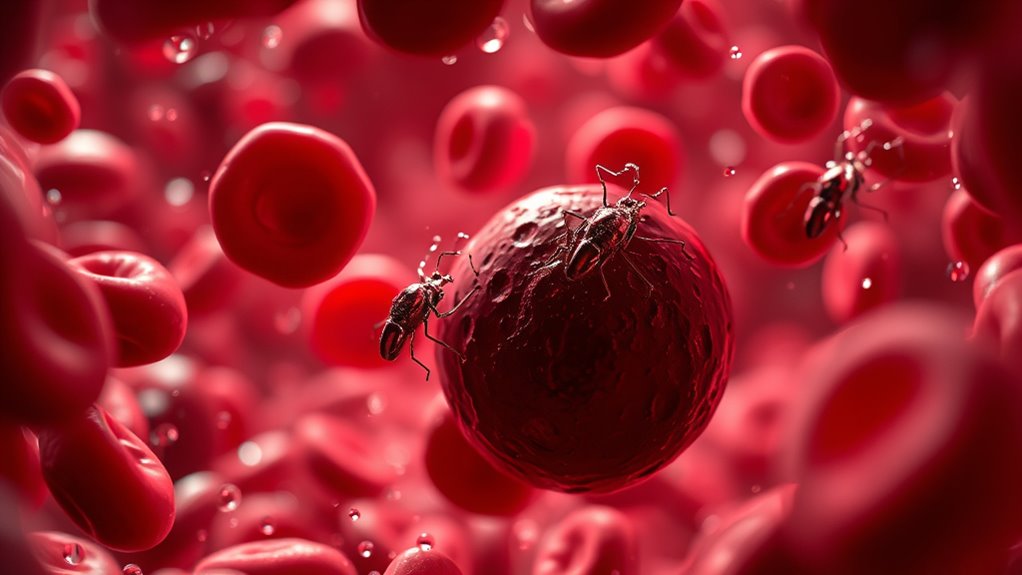Using nanorobots for blood clot removal allows you to experience highly targeted, minimally invasive treatment. These tiny robots navigate your blood vessels with advanced imaging and internal GPS, precisely locating clots. They recognize biochemical markers and release clot-dissolving agents directly at the blockage. This controlled process minimizes damage to healthy tissue and speeds recovery. To discover more about how this cutting-edge technology works and its benefits, keep exploring further.
Key Takeaways
- Nanorobots can navigate directly to blood clots using advanced imaging and internal GPS systems.
- They detect clots precisely through embedded sensors targeting specific biochemical markers.
- Therapeutic actions include releasing clot-dissolving agents or physically fragmenting the clot.
- Real-time feedback allows nanorobots to adjust their course for safe, targeted treatment.
- This minimally invasive approach reduces risks and accelerates recovery compared to traditional methods.

Nanorobots are revolutionizing the way we approach blood clot removal by offering targeted and minimally invasive solutions. These tiny devices can travel directly to the site of a blood clot, enabling precise intervention while reducing the risks associated with traditional surgical methods. To achieve this, nanorobot navigation becomes essential. You can think of it as an internal GPS system, guiding the nanorobots through complex blood vessels with remarkable accuracy. Advanced imaging techniques, like MRI or ultrasound, help these nanorobots find their way, allowing them to move seamlessly through the bloodstream. Once inside, their ability to detect blood clots is vital. Blood clot detection relies on sensors embedded within the nanorobots that recognize specific biochemical markers or physical characteristics unique to clots. This targeted detection ensures that the nanorobots don’t mistakenly act on healthy tissue, minimizing unnecessary damage. Navigation techniques play a crucial role in ensuring precise movement and effective treatment.
When blood clot detection is successful, the nanorobots can start their therapeutic actions. They may release clot-dissolving agents directly into the clot, breaking it down efficiently. Alternatively, some nanorobots are designed to physically remove or fragment the clot, making it easier for the body to clear away the debris naturally. Because these devices are so small, they can access even the tiniest blood vessels, reaching areas that traditional treatments might miss. This precision reduces the likelihood of side effects and accelerates recovery times.
The navigation process is dynamic, often involving real-time feedback systems that adjust the nanorobots’ course as they encounter obstacles or complex vessel structures. This adaptability is crucial for ensuring the nanorobots stay on track and reach the clot without causing unintended damage or dislodging other blood components. As they approach the clot, their sensors become more active, confirming they’ve found the right target before performing their task. This level of control is unprecedented in medical treatments, allowing for safer and more effective interventions.
Frequently Asked Questions
How Long Do Nanorobots Remain Active in the Bloodstream?
Nanorobot lifespan in your bloodstream varies, but typically they remain active for hours to days. During this time, their bloodstream activity is precisely controlled to target and remove blood clots effectively. Once their task is complete, your body naturally breaks down or removes the nanorobots. Their active duration depends on design and purpose, but generally, they stay functional long enough to accomplish clot removal before safely degrading.
Can Nanorobots Target Multiple Clots Simultaneously?
Yes, nanorobots can target multiple clots simultaneously through meticulous micro-manipulation. With advanced nanorobot coordination, they synchronize swiftly, scanning and striking multiple sites with precision. This multitasking marvel maximizes medical efficiency, minimizing risks and treatment time. You’ll see nanorobots work wonders, weaving through bloodstream barriers to tackle several clots at once, creating a clear, clot-free course through your circulatory system.
What Are the Potential Side Effects of Nanorobot Treatment?
You might experience an immune response as your body recognizes the nanorobots, leading to inflammation or allergic reactions. There’s also a risk of tissue damage if the nanorobots malfunction or interact unpredictably with surrounding cells. While these treatments are promising, they could cause side effects like inflammation, immune reactions, or unintended tissue injury. Monitoring and advancements aim to minimize these risks for safer, more effective blood clot removal.
How Are Nanorobots Directed to the Clot Site?
You can direct nanorobots to the clot site using magnetic guidance, where external magnets steer them precisely, or through chemical targeting, where they respond to specific molecules found at the clot. By combining these methods, you guarantee accurate delivery, minimizing risks. Magnetic guidance allows for real-time control, while chemical targeting enhances specificity. This dual approach helps your nanorobots reach the clot efficiently and safely.
Are Nanorobots Reusable or Single-Use?
Nanorobots are generally designed for single-use due to concerns about nanorobot durability and potential contamination. Reusing them isn’t common because sterilization and maintaining their integrity can be challenging. Regulatory challenges also limit their reuse, as safety and efficacy must be thoroughly validated for each procedure. Currently, most systems favor disposable nanorobots to guarantee patient safety and meet strict regulatory standards.
Conclusion
Imagine controlling tiny nanorobots that can target blood clots precisely, reducing risks and recovery times. Studies show these nanorobots could improve clot removal success rates by up to 90%, making treatments safer and more efficient. As technology advances, you’ll see fewer complications and quicker recoveries. This breakthrough could transform how we treat blood clots, giving you hope for better health outcomes with less invasive procedures. The future of medicine is closer than you think!









